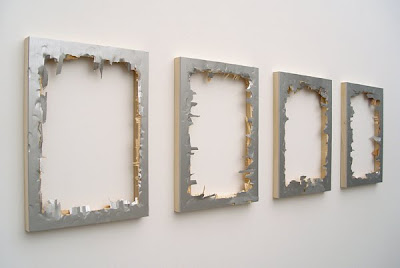Click here for Minus Space
Click here for Albers/Albums
Click here for Brooklyn Rail exhibition review
Click here for Josef Albers
Saturday, January 9, 2010
Mostly Monochrome, McKenzie Fine Art, New York, NY, January 7 - February 6, 2010
Tuesday, December 22, 2009
Visual Discrepencies; Conversations
An ongoing series of interviews by artist Brent Hallard from his blog.
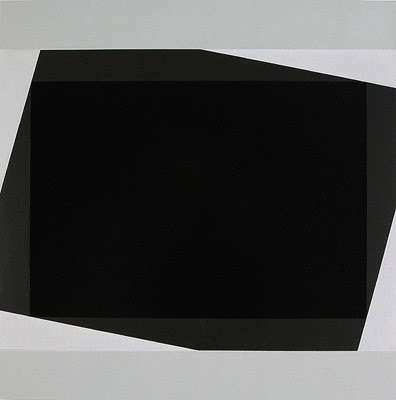
Click here for Conversation with Don Voisine (above)
Click here for Conversation with Linda Francis (above)
Click here for Conversation with Richard van der Aa (above)
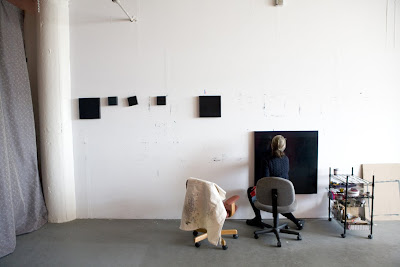
Click here for Conversation with Mel Priest (above)
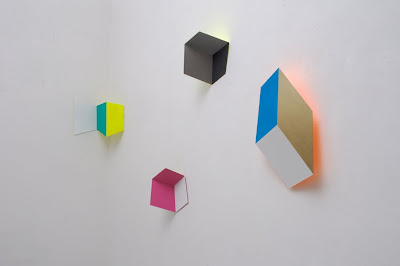
Click here for conversation with Henriette van't Hoog (above)

Click here for Conversation with Alan Ebnother (above)
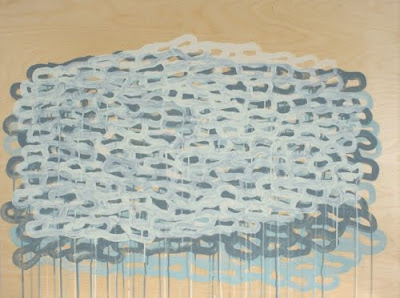
Click here for Conversation with Tim McFarlane (above)
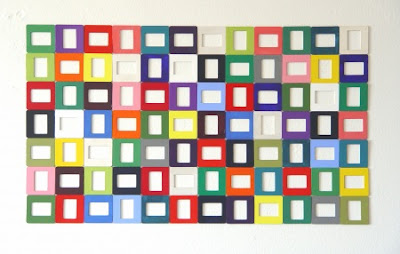
Click here for Conversation with Patricia Zarate (above)

Click here for Conversation with Linda Arts (above)
Click here for Conversation with Devin Powers (above)
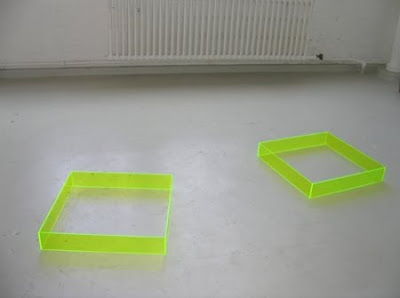
Click here for Conversation with Lynne Harlow (above)

Click here for Conversation with Kasarian Dane (above)

Click here for Conversation with Richard Roth (above)
Monday, December 21, 2009
Dieter Balzer, Gallery Sonja Roesch, Houston, TX, November 7, 2009 - January 2, 2010
Click here for Gallery Sonja Roesch
Click here for the website of Dieter Balzer
Review from Artforum:
Precision in reductive-themed art is not merely essential but also the means and the end of such work. Dieter Balzer’s recent exhibition on view at Gallery Sonja Roesch exemplifies the genre’s correlation between presentation and execution. His elegantly constructed, wall-mounted linear sculptures are a delight. Brightly colored monochromatic bars overlap, intertwine, and obfuscate in prescribed rhythms that uniquely balance each piece. The artist displays an understanding of the logic of randomness, as it were, in that his creations hold steady to a purpose that is self-contained—playfully executing their own systemic patterning with grace and authority. Balzer exemplifies a mature understanding of spatial depth, both illusory and real, that makes the complicated works appear at once effortless and fully realized. References from Sol LeWitt to Jo Baer come to mind but fail to fully capture Balzer’s unique configurations, which have freshness apart from historical precedent. The wise decision to include relatively few forms in the show strengthens the presence of the artworks—each of which displays its own syncopated trajectory.
At 94, She’s the Hot New Thing in Painting
Carmen Herrera
Click here for images of work
Deborah Sontag
New York Times
December 19, 2009
Under a skylight in her tin-ceilinged loft near Union Square in Manhattan, the abstract painter Carmen Herrera, 94, nursed a flute of Champagne last week, sitting regally in the wheelchair she resents.
After six decades of very private painting, Ms. Herrera sold her first artwork five years ago, at 89. Now, at a small ceremony in her honor, she was basking in the realization that her career had finally, undeniably, taken off. As cameras flashed, she extended long, Giacomettiesque fingers to accept an art foundation’s lifetime achievement award from the director of the Walker Art Center in Minneapolis.
Her good friend, the painter Tony Bechara, raised a glass. “We have a saying in Puerto Rico,” he said. “The bus — la guagua — always comes for those who wait.”
And the Cuban-born Ms. Herrera, laughing gustily, responded, “Well, Tony, I’ve been at the bus stop for 94 years!”
Since that first sale in 2004, collectors have avidly pursued Ms. Herrera, and her radiantly ascetic paintings have entered the permanent collections of institutions like the Museum of Modern Art, the Hirshhorn Museum and the Tate Modern. Last year, MoMA included her in a pantheon of Latin American artists on exhibition. And this summer, during a retrospective show in England, The Observer of London called Ms. Herrera the discovery of the decade, asking, “How can we have missed these beautiful compositions?”
In a word, Ms. Herrera, a nonagenarian homebound painter with arthritis, is hot. In an era when the art world idolizes, and often richly rewards, the young and the new, she embodies a different, much rarer kind of success, that of the artist long overlooked by the market, and by history, who persevered because she had no choice.
“I do it because I have to do it; it’s a compulsion that also gives me pleasure,” she said of painting. “I never in my life had any idea of money and I thought fame was a very vulgar thing. So I just worked and waited. And at the end of my life, I’m getting a lot of recognition, to my amazement and my pleasure, actually.”
Julián Zugazagoitia, the director of El Museo del Barrio in East Harlem, called Ms. Herrera “a quiet warrior of her art.”
“To bloom into full glory at 94 — whatever Carmen Herrera’s slow rise might say about the difficulties of being a woman artist, an immigrant artist or an artist ahead of her time, it is clearly a story of personal strength,” Mr. Zugazagoitia said.
A minimalist whose canvases are geometric distillations of form and color, Ms. Herrera has slowly come to the attention of a subset of art historians over the last decade. . Now she is increasingly considered an important figure by those who study her “remarkably monumental, iconic paintings,” said Edward J. Sullivan, a professor of art history at New York University.
“Those of us with a passion for either geometric art or Latin American Modernist painting now realize what a pivotal role” Ms. Herrera has played in “the development of geometric abstraction in the Americas,” Mr. Sullivan said.
Painting in relative solitude since the late 1930s, with only the occasional exhibition, Ms. Herrera was sustained, she said, by the unflinching support of her husband of 61 years, Jesse Loewenthal. An English teacher at Stuyvesant High School in Manhattan, Mr. Loewenthal was portrayed by the memoirist Frank McCourt, a colleague, as an old-world scholar in an “elegant, three-piece suit, the gold watch chain looping across his waistcoat front.”
Recognition for Ms. Herrera came a few years after her husband’s death, at 98, in 2000. “Everybody says Jesse must have orchestrated this from above,” Ms. Herrera said, shaking her head. “Yeah, right, Jesse on a cloud.” She added: “I worked really hard. Maybe it was me.”
In a series of interviews in her sparsely but artfully furnished apartment, Ms. Herrera always offered an afternoon cocktail — “Oh, don’t be abstemious!” — and an outpouring of stories about prerevolutionary Cuba, postwar Paris and the many artists she has known, from Wifredo Lam to Yves Klein to Barnett Newman.
“Ah, Wifredo,” she said, referring to Lam, the Cuban-born French painter. “All the girls were crazy about him. When we were in Havana, my phone would begin ringing: ‘Is Wifredo in town?’ I mean, come on, I wasn’t his social secretary.”
But Ms. Herrera is less expansive about her own art, discussing it with a minimalism redolent of the work. “Paintings speak for themselves,” she said. Geometry and color have been the head and the heart of her work, she added, describing a lifelong quest to pare down her paintings to their essence, like visual haiku.
Asked how she would describe to a student a painting like “Blanco y Verde” (1966) — a canvas of white interrupted by an inverted green triangle — she said, “I wouldn’t have a student.” To a sweet, inquiring child, then? “I’d give him some candy so he’d rot his teeth.”
When pressed about what looks to some like a sensual female shape in the painting, she said: “Look, to me it was white, beautiful white, and then the white was shrieking for the green, and the little triangle created a force field. People see very sexy things — dirty minds! — but to me sex is sex, and triangles are triangles.”
Born in 1915 in Havana, where her father was the founding editor of the daily newspaper El Mundo, and her mother a reporter, Ms. Herrera took art lessons as a child, attended finishing school in Paris and embarked on a Cuban university degree in architecture. In 1939, midway through her studies, she married Mr. Loewenthal and moved to New York. (They had no children.)
Although she studied at the Art Students League of New York, Ms. Herrera did not discover her artistic identity until she and her husband settled in Paris for a few years after World War II. There she joined a group of abstract artists, based at the influential Salon of New Realities, which exhibited her work along with that of Josef Albers, Jean Arp, Sonia Delaunay and others.
“I was looking for a pictorial vocabulary and I found it there,” she said. “But when we moved back to New York, this type of art” — her less-is-more formalism — “was not acceptable. Abstract Expressionism was in fashion. I couldn’t get a gallery.”
Ms. Herrera said that she also accepted, “as a handicap,” the barriers she faced as a Hispanic female artist. Beyond that, though, “her art was not easily digestible at the time,” Mr. Zugazagoitia said. “She was not doing Cuban landscapes or flowers of the tropics, the art you might have expected from a Cuban émigré who spent time in Paris. She was ahead of her time.”
Over the decades, Ms. Herrera had a solo show here and there, including a couple at museums (the Alternative Museum in 1984, El Museo del Barrio in 1998). But she never sold anything, and never needed, or aggressively sought, the affirmation of the market. “It would have been nice, but maybe corrupting,” she said.
Mr. Bechara, who befriended her in the early 1970s and is now chairman of El Museo del Barrio, said that he regularly tried to push her into the public eye, even though she “found a kind of solace in being alone.”
One day in 2004, Mr. Bechara attended a dinner with Frederico Sève, the owner of the Latin Collector Gallery in Manhattan, who was dealing with the withdrawal of an artist from a much-publicized show of female geometric painters. “Tony said to me: ‘Geometry and ladies? You need Carmen Herrera,’ ” Mr. Sève recounted. “And I said, ‘Who the hell is Carmen Herrera?’ ”
The next morning, Mr. Sève arrived at his gallery to find several paintings, just delivered, that he took to be the work of the well-known Brazilian artist Lygia Clark but were in fact by Ms. Herrera. Turning over the canvases, he saw that they predated by a decade paintings in a similar style by Ms. Clark. “Wow, wow, wow,” he recalled saying. “We got a pioneer here.”
Mr. Sève quickly called Ella Fontanals-Cisneros, a collector who has an art foundation in Miami. She bought five of Ms. Herrera’s paintings. Estrellita Brodsky, another prominent collector, bought another five. Agnes Gund, president emerita of the Museum of Modern Art, also bought several, and with Mr. Bechara, donated one of Ms. Herrera’s black-and-white paintings to MoMA.
The recent exhibition in England, which is now heading to Germany, came about by happenstance after a curator stumbled across Ms. Herrera’s paintings on the Internet. Last week The Observer named that retrospective one of the year’s 10 best exhibitions, alongside a Picasso show and one devoted to the American Pop artist Ed Ruscha.
Ms. Herrera’s late-in-life success has stunned her in many ways. Her larger works now sell for $30,000, and one painting commanded $44,000 — sums unimaginable when she was, say, in her 80s. “I have more money now than I ever had in my life,” she said.
Not that she is succumbing to a life of leisure. At a long table where she peers out over East 19th Street “like a French concierge,” Ms. Herrera, because she must, continues to draw and paint. “Only my love of the straight line keeps me going,” she said.
Click here for images of work
Deborah Sontag
New York Times
December 19, 2009
Under a skylight in her tin-ceilinged loft near Union Square in Manhattan, the abstract painter Carmen Herrera, 94, nursed a flute of Champagne last week, sitting regally in the wheelchair she resents.
After six decades of very private painting, Ms. Herrera sold her first artwork five years ago, at 89. Now, at a small ceremony in her honor, she was basking in the realization that her career had finally, undeniably, taken off. As cameras flashed, she extended long, Giacomettiesque fingers to accept an art foundation’s lifetime achievement award from the director of the Walker Art Center in Minneapolis.
Her good friend, the painter Tony Bechara, raised a glass. “We have a saying in Puerto Rico,” he said. “The bus — la guagua — always comes for those who wait.”
And the Cuban-born Ms. Herrera, laughing gustily, responded, “Well, Tony, I’ve been at the bus stop for 94 years!”
Since that first sale in 2004, collectors have avidly pursued Ms. Herrera, and her radiantly ascetic paintings have entered the permanent collections of institutions like the Museum of Modern Art, the Hirshhorn Museum and the Tate Modern. Last year, MoMA included her in a pantheon of Latin American artists on exhibition. And this summer, during a retrospective show in England, The Observer of London called Ms. Herrera the discovery of the decade, asking, “How can we have missed these beautiful compositions?”
In a word, Ms. Herrera, a nonagenarian homebound painter with arthritis, is hot. In an era when the art world idolizes, and often richly rewards, the young and the new, she embodies a different, much rarer kind of success, that of the artist long overlooked by the market, and by history, who persevered because she had no choice.
“I do it because I have to do it; it’s a compulsion that also gives me pleasure,” she said of painting. “I never in my life had any idea of money and I thought fame was a very vulgar thing. So I just worked and waited. And at the end of my life, I’m getting a lot of recognition, to my amazement and my pleasure, actually.”
Julián Zugazagoitia, the director of El Museo del Barrio in East Harlem, called Ms. Herrera “a quiet warrior of her art.”
“To bloom into full glory at 94 — whatever Carmen Herrera’s slow rise might say about the difficulties of being a woman artist, an immigrant artist or an artist ahead of her time, it is clearly a story of personal strength,” Mr. Zugazagoitia said.
A minimalist whose canvases are geometric distillations of form and color, Ms. Herrera has slowly come to the attention of a subset of art historians over the last decade. . Now she is increasingly considered an important figure by those who study her “remarkably monumental, iconic paintings,” said Edward J. Sullivan, a professor of art history at New York University.
“Those of us with a passion for either geometric art or Latin American Modernist painting now realize what a pivotal role” Ms. Herrera has played in “the development of geometric abstraction in the Americas,” Mr. Sullivan said.
Painting in relative solitude since the late 1930s, with only the occasional exhibition, Ms. Herrera was sustained, she said, by the unflinching support of her husband of 61 years, Jesse Loewenthal. An English teacher at Stuyvesant High School in Manhattan, Mr. Loewenthal was portrayed by the memoirist Frank McCourt, a colleague, as an old-world scholar in an “elegant, three-piece suit, the gold watch chain looping across his waistcoat front.”
Recognition for Ms. Herrera came a few years after her husband’s death, at 98, in 2000. “Everybody says Jesse must have orchestrated this from above,” Ms. Herrera said, shaking her head. “Yeah, right, Jesse on a cloud.” She added: “I worked really hard. Maybe it was me.”
In a series of interviews in her sparsely but artfully furnished apartment, Ms. Herrera always offered an afternoon cocktail — “Oh, don’t be abstemious!” — and an outpouring of stories about prerevolutionary Cuba, postwar Paris and the many artists she has known, from Wifredo Lam to Yves Klein to Barnett Newman.
“Ah, Wifredo,” she said, referring to Lam, the Cuban-born French painter. “All the girls were crazy about him. When we were in Havana, my phone would begin ringing: ‘Is Wifredo in town?’ I mean, come on, I wasn’t his social secretary.”
But Ms. Herrera is less expansive about her own art, discussing it with a minimalism redolent of the work. “Paintings speak for themselves,” she said. Geometry and color have been the head and the heart of her work, she added, describing a lifelong quest to pare down her paintings to their essence, like visual haiku.
Asked how she would describe to a student a painting like “Blanco y Verde” (1966) — a canvas of white interrupted by an inverted green triangle — she said, “I wouldn’t have a student.” To a sweet, inquiring child, then? “I’d give him some candy so he’d rot his teeth.”
When pressed about what looks to some like a sensual female shape in the painting, she said: “Look, to me it was white, beautiful white, and then the white was shrieking for the green, and the little triangle created a force field. People see very sexy things — dirty minds! — but to me sex is sex, and triangles are triangles.”
Born in 1915 in Havana, where her father was the founding editor of the daily newspaper El Mundo, and her mother a reporter, Ms. Herrera took art lessons as a child, attended finishing school in Paris and embarked on a Cuban university degree in architecture. In 1939, midway through her studies, she married Mr. Loewenthal and moved to New York. (They had no children.)
Although she studied at the Art Students League of New York, Ms. Herrera did not discover her artistic identity until she and her husband settled in Paris for a few years after World War II. There she joined a group of abstract artists, based at the influential Salon of New Realities, which exhibited her work along with that of Josef Albers, Jean Arp, Sonia Delaunay and others.
“I was looking for a pictorial vocabulary and I found it there,” she said. “But when we moved back to New York, this type of art” — her less-is-more formalism — “was not acceptable. Abstract Expressionism was in fashion. I couldn’t get a gallery.”
Ms. Herrera said that she also accepted, “as a handicap,” the barriers she faced as a Hispanic female artist. Beyond that, though, “her art was not easily digestible at the time,” Mr. Zugazagoitia said. “She was not doing Cuban landscapes or flowers of the tropics, the art you might have expected from a Cuban émigré who spent time in Paris. She was ahead of her time.”
Over the decades, Ms. Herrera had a solo show here and there, including a couple at museums (the Alternative Museum in 1984, El Museo del Barrio in 1998). But she never sold anything, and never needed, or aggressively sought, the affirmation of the market. “It would have been nice, but maybe corrupting,” she said.
Mr. Bechara, who befriended her in the early 1970s and is now chairman of El Museo del Barrio, said that he regularly tried to push her into the public eye, even though she “found a kind of solace in being alone.”
One day in 2004, Mr. Bechara attended a dinner with Frederico Sève, the owner of the Latin Collector Gallery in Manhattan, who was dealing with the withdrawal of an artist from a much-publicized show of female geometric painters. “Tony said to me: ‘Geometry and ladies? You need Carmen Herrera,’ ” Mr. Sève recounted. “And I said, ‘Who the hell is Carmen Herrera?’ ”
The next morning, Mr. Sève arrived at his gallery to find several paintings, just delivered, that he took to be the work of the well-known Brazilian artist Lygia Clark but were in fact by Ms. Herrera. Turning over the canvases, he saw that they predated by a decade paintings in a similar style by Ms. Clark. “Wow, wow, wow,” he recalled saying. “We got a pioneer here.”
Mr. Sève quickly called Ella Fontanals-Cisneros, a collector who has an art foundation in Miami. She bought five of Ms. Herrera’s paintings. Estrellita Brodsky, another prominent collector, bought another five. Agnes Gund, president emerita of the Museum of Modern Art, also bought several, and with Mr. Bechara, donated one of Ms. Herrera’s black-and-white paintings to MoMA.
The recent exhibition in England, which is now heading to Germany, came about by happenstance after a curator stumbled across Ms. Herrera’s paintings on the Internet. Last week The Observer named that retrospective one of the year’s 10 best exhibitions, alongside a Picasso show and one devoted to the American Pop artist Ed Ruscha.
Ms. Herrera’s late-in-life success has stunned her in many ways. Her larger works now sell for $30,000, and one painting commanded $44,000 — sums unimaginable when she was, say, in her 80s. “I have more money now than I ever had in my life,” she said.
Not that she is succumbing to a life of leisure. At a long table where she peers out over East 19th Street “like a French concierge,” Ms. Herrera, because she must, continues to draw and paint. “Only my love of the straight line keeps me going,” she said.
Friday, December 18, 2009
Gracia Khouw en Elisabeth Soneck, Galerie Hein Elferink, Staphorst, Netherlands, October 24-December 5, 2009
Click here for the website of Galerie Hein Elferink
Click here for the website of Gracia Khouw
Click here for the website of Elisabeth Sonneck
Elisabeth Sonneck
Gracia Khouw
Click here for the website of Gracia Khouw
Click here for the website of Elisabeth Sonneck
Elisabeth Sonneck
Gracia Khouw
Tuesday, December 1, 2009
Planes of Abstraction, Center for Maine Contemporary Art, Rockport, Maine, October 14 - December 19, 2009
Don Voisine, Winston Roeth, Scott Davis, Jeff Kellar, and Duane Paluska
Simple and distinct
Solid, serious abstractions at CMCA
By KEN GREENLEAF | November 11, 2009
“Planes of Abstraction” at the Maine Center for Contemporary Art brings together five artists with broad experience who share a common interest in a simplified image. They are otherwise quite different from one another in their purposes and methods. The artists are Don Voisine, Winston Roeth, Scott Davis, Jeff Kellar, and Duane Paluska.
In Voisine’s “Veer,” two broad, nearly black shapes cross each other in the space between two narrow lines of yellow ochre along the painting’s top and bottom borders. The black masses create a sense that the painting is an object. That’s an illusion, of course, and as you look at the painting the feeling of mass conflicts with the plain fact that these are large areas of paint, creating an expressive tension. Of all the works in the show, Voisine’s are the most abstract, in that they exist as a statement outside any concrete reality or rhetorical reference.
Roeth’s paintings, by contrast, are not conceptually abstract at all. Here he shows three distinct modes: “Split Blue Square,” two related blue rectangular panels hung one over the other; “Savannah Moon,” a square dark painting with a few concentric circles; and “Sorcerer,” 12 slate roofing shingles hung in a three-by-four grid, each painted a different color.
Roeth’s works are primarily about light. The two halves of “Split Blue Square” are distinguished not so much by their color as by the light emanating from them — their moods are distinct, and it makes gives them an expressive shimmer. Even in “Sorcerer,” where the chipped edges of the slates and holes for the mounting nails are make it clear they are mundane objects, the overall effect is one of opulent light radiating from some inner source.
Davis’s paintings are images that refer to something other than the work itself. He creates a scene whose content is spare but hints at some reality outside normal experience. “Parapet” is a field of blue with a geometric yellow shape along its bottom border that resembles a parapet as seen from below. But something is off — the perspective seems right, but isn’t, quite. It’s as if the painting was correct and our normal notions of perspective don’t apply. Davis is subtly bringing us into his own universe with its own rules, while providing us with a semiotic sign we can’t quite grasp.
Kellar’s works are almost non-corporeal, the opposite of Voisine’s. They are done with a special coating on aluminum and seem to float in space an inch off the wall. This is a deliberate strategy — he’s gone to great lengths to direct the viewer’s attention away from seeing it as a painting and toward his actual content, which is the interplay of a subtle surface with line or color. In “Folded” the upper third of the painting is red, the bottom is white, and there’s a shallow angle in the border between them. It feels a little folded; the tension between that illusion and the soft, tangible surface is central to his work.
Paluska’s painted wood sculptures are more complex. The linear elements of his constructions join at angles that render them slightly skewed away from where familiar perspective would put them if they were, say, a chair tipped over. In “Blue Moon” a flat segment of a circle is held vertically on wooden framework. As you walk around the piece you see its edge as it aligns, and then doesn’t, with the angles of the structure. The effect is a subtle dimensional unfolding and refolding and unfolding again.
It’s an uncommon treat, in these parts, to see a show of the work of highly accomplished, veteran abstract artists gathered into one room. Much of what we see today is shallow, noisy, and meant to overwhelm for a moment. These works are quiet, focused, and deep enough to reward close attention and extended thought.
Simple and distinct
Solid, serious abstractions at CMCA
By KEN GREENLEAF | November 11, 2009
“Planes of Abstraction” at the Maine Center for Contemporary Art brings together five artists with broad experience who share a common interest in a simplified image. They are otherwise quite different from one another in their purposes and methods. The artists are Don Voisine, Winston Roeth, Scott Davis, Jeff Kellar, and Duane Paluska.
In Voisine’s “Veer,” two broad, nearly black shapes cross each other in the space between two narrow lines of yellow ochre along the painting’s top and bottom borders. The black masses create a sense that the painting is an object. That’s an illusion, of course, and as you look at the painting the feeling of mass conflicts with the plain fact that these are large areas of paint, creating an expressive tension. Of all the works in the show, Voisine’s are the most abstract, in that they exist as a statement outside any concrete reality or rhetorical reference.
Roeth’s paintings, by contrast, are not conceptually abstract at all. Here he shows three distinct modes: “Split Blue Square,” two related blue rectangular panels hung one over the other; “Savannah Moon,” a square dark painting with a few concentric circles; and “Sorcerer,” 12 slate roofing shingles hung in a three-by-four grid, each painted a different color.
Roeth’s works are primarily about light. The two halves of “Split Blue Square” are distinguished not so much by their color as by the light emanating from them — their moods are distinct, and it makes gives them an expressive shimmer. Even in “Sorcerer,” where the chipped edges of the slates and holes for the mounting nails are make it clear they are mundane objects, the overall effect is one of opulent light radiating from some inner source.
Davis’s paintings are images that refer to something other than the work itself. He creates a scene whose content is spare but hints at some reality outside normal experience. “Parapet” is a field of blue with a geometric yellow shape along its bottom border that resembles a parapet as seen from below. But something is off — the perspective seems right, but isn’t, quite. It’s as if the painting was correct and our normal notions of perspective don’t apply. Davis is subtly bringing us into his own universe with its own rules, while providing us with a semiotic sign we can’t quite grasp.
Kellar’s works are almost non-corporeal, the opposite of Voisine’s. They are done with a special coating on aluminum and seem to float in space an inch off the wall. This is a deliberate strategy — he’s gone to great lengths to direct the viewer’s attention away from seeing it as a painting and toward his actual content, which is the interplay of a subtle surface with line or color. In “Folded” the upper third of the painting is red, the bottom is white, and there’s a shallow angle in the border between them. It feels a little folded; the tension between that illusion and the soft, tangible surface is central to his work.
Paluska’s painted wood sculptures are more complex. The linear elements of his constructions join at angles that render them slightly skewed away from where familiar perspective would put them if they were, say, a chair tipped over. In “Blue Moon” a flat segment of a circle is held vertically on wooden framework. As you walk around the piece you see its edge as it aligns, and then doesn’t, with the angles of the structure. The effect is a subtle dimensional unfolding and refolding and unfolding again.
It’s an uncommon treat, in these parts, to see a show of the work of highly accomplished, veteran abstract artists gathered into one room. Much of what we see today is shallow, noisy, and meant to overwhelm for a moment. These works are quiet, focused, and deep enough to reward close attention and extended thought.
Sunday, November 29, 2009
Susanne Jung, Rolf Rose, Don Voisine, pp projects, Hamburg, Germany
Click here for Don Voisine
Click here for Susanne Jung
Click here for Rolf Rose
Susanne Jung
Don Voisine
Rolf Rose
Click here for Susanne Jung
Click here for Rolf Rose
Susanne Jung
Don Voisine
Rolf Rose
Wednesday, November 25, 2009
Friday, November 6, 2009
Last Post (at least for awhlie)
I am downscaling the listings portion of Reductive Painting to concentrate on The Perceptual Observer. Please refer to Minus Space for current updates on reductive painting exhibitions worldwide.
I will continue to update the listing of artists' websites on this blog from time to time.
Thanks for looking.
I will continue to update the listing of artists' websites on this blog from time to time.
Thanks for looking.
Saturday, October 3, 2009
Color-Time-Space, Janet Kurnatowski, Brooklyn, NY, September 10-October 11, 2009
Curated by Joanne Freeman and Kim Uchiyama
Click here for Janet Kurnatowski
James Biederman, Laurie Fendrich, Joanne Freeman, Julie Gross, Ben LaRocco, Gary Petersen, Kazimira Rachfal, Jennifer Riley, Yvonne Thomas, Kim Uchiyama, Stephen Westfall, Thornton Willis, Kevin Wixted

Gary Petersen
Click here for Janet Kurnatowski
James Biederman, Laurie Fendrich, Joanne Freeman, Julie Gross, Ben LaRocco, Gary Petersen, Kazimira Rachfal, Jennifer Riley, Yvonne Thomas, Kim Uchiyama, Stephen Westfall, Thornton Willis, Kevin Wixted

Gary Petersen
Color-Time-Space, Lohin Geduld Gallery, New York, NY, September 10-October 11, 2009
Curated by Joanne Freeman and Kim Uchiyama
Click here for Lohin Geduld Gallery
James Biederman, Laurie Fendrich, Joanne Freeman, Julie Gross, Ben LaRocco, Gary Petersen, Kazimira Rachfal, Jennifer Riley, Yvonne Thomas, Kim Uchiyama, Stephen Westfall, Thornton Willis, Kevin Wixted

Stephen Westfall
Click here for Lohin Geduld Gallery
James Biederman, Laurie Fendrich, Joanne Freeman, Julie Gross, Ben LaRocco, Gary Petersen, Kazimira Rachfal, Jennifer Riley, Yvonne Thomas, Kim Uchiyama, Stephen Westfall, Thornton Willis, Kevin Wixted

Stephen Westfall
Giles Ryder, CCNOA, Brussels, Belgium, September 3 - October 4, 2009
Click here for Giles Ryder
Click here for more on Center for Contemporary Non Objective Art

Click here for Giles Ryder
Click here for more on Center for Contemporary Non Objective Art

Click here for Giles Ryder
Tuesday, August 11, 2009
Monday, August 10, 2009
Blue, James Graham & Sons, New York, NY, June 16-August 28, 2009
Saturday, August 1, 2009
Personal Space, Paris Concret, Paris, France, June, 2009
Henriëtte van't Hoog, Richard Roth, Brent Hallard
http://www.parisconcret.org/

Richard Roth

Henriëtte van't Hoog

Brent Hallard
http://www.parisconcret.org/

Richard Roth

Henriëtte van't Hoog

Brent Hallard
Tuesday, May 12, 2009
Kosmos, IS Projects, Leiden, The Netherlands, June 6-July 5, 2009
Exposanten Raster en Ritueel, Gorinchem, Netherlands, April 26-May 24, 2009
Subscribe to:
Posts (Atom)

